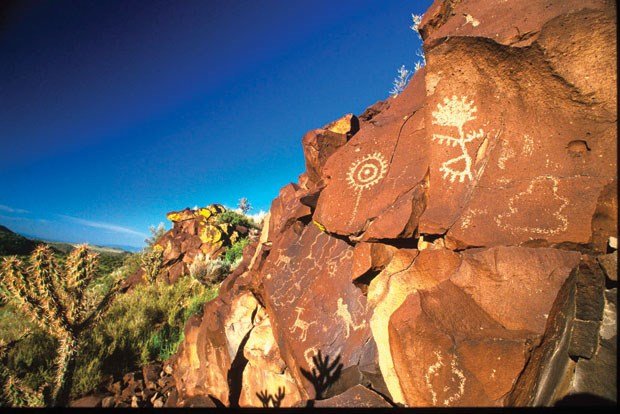You can't escape the past in Santa Fe. It clings to you at every corner, stares at you from every doorway and window, and speaks to you from the ancient cliff dwellings in the nearby hills.
Here you'll find a physical and spiritual combination of an aboriginal culture, an imported European past and chic 21st century Americana.
No Disney-style themepark, this. It's all real - a city of narrow, winding streets, inaudible serenity, tan adobe walls and hundred-year-old shade trees. It nurtures and guards its 18th century look, preferring historic Spanish designs to contemporary architecture, the central core laid out to accommodate the needs of the 17th century, not the 21st.
It's easy to be sidetracked in Santa Fe with its 400 restaurants, 250 art galleries, 70 jewelry shops, 14 museums and vibrant arts scene. But restaurants and art galleries are not all that draw people to what is also the smallest state capital in the U.S.
The Hopi, the Navajo, the Spanish, even the ancient peoples called the Ancestral Puebloans, have all imprinted the region. It's a cultural potpourri that can be seen, worn and touched.
Canyon Road is a winding, uphill street east of downtown that houses the tacky, the beautiful and the always fascinating shops and small galleries where you can find everything Southwestern you ever thought you wanted.
Santa Fe dates from 1610 when Spanish explorers pushed up from Mexico along the Santa Fe Trail. Today's street names attest to its Spanish and Mexican past. Santa Fe, for those curious about such things, means "Holy Faith" in Spanish.
The heart of the old town is the scenic Plaza, site of cultural events throughout the year, including the Indian Market during the third week in August, the largest juried Indian arts and crafts show in the world. Paintings, pottery and jewelry are fashioned by some of the region's most celebrated artists and designers.
In 1680, Spanish and Natives clashed for control of the city and territory on that spot. The Spanish, having only about 150 soldiers to hold the area, lost it to the Pueblo Indians, but recaptured it in the summer of 1692.
You can get a taste of what life was like in old Santa Fe by visiting San Miguel Chapel, the city's oldest church, built in the 1600s by the Tlaxcala Indians who came from Mexico as servants of the Spanish conquistadors. In it is the San Jose Bell, built in Spain in 1356 and transported from Mexico City along the Santa Fe Trail. Next door is a terrific gift shop in what is thought to be the oldest house in America. On the edge of the Plaza is the Palace of the Governors, built in 1610 to house the first Spanish governor. It's now the museum of history for New Mexico and should be the first place to head to for a background on what makes the city tick.
Across the street is the Museum of Fine Arts with its collection of 8,000 art pieces, including those of Georgia O'Keeffe and well known New Mexican artists. There is also a standalone Georgia O'Keeffe Museum about two blocks northwest of the Plaza. No trip to Santa Fe is complete without an exploration of the ancient people that started the whole thing centuries ago, the Ancestral Puebloans civilization.
At Bandelier National Monument - near Los Alamos, an hour's drive from Santa Fe - climb through the cave rooms that housed these ancient people. Stand at the centre of the kiva, the heart of the old community, and glance upwards into the cliff sides. It's a haunting place.
Travel Writers' Tales is an independent newspaper syndicate that offers professionally written travel articles to newspaper editors and publishers.



